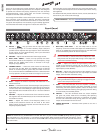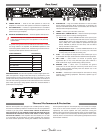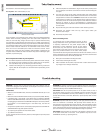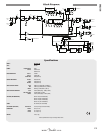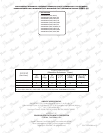
ENGLISH
10
The Bassman® uses the following types of tubes:
Pre-Amplifier: Two 12AX7A tubes (V1, V2)
V2 (12AX7A)
V1 (12AX7A)
(Chassis, bottom view)
If your amplifier is not performing as it should, refer to the Troubleshooting
section below. Generally speaking with most tube audio amplifiers the
tubes are the most likely thing to fail and may be replaced without taking
your amplifier to a qualified service technician. If any tubes need replacing,
carefully read and follow these steps. If you do not feel comfortable replacing
your amplifier's tubes, take it to an authorized Fender service center. All other
service needs should be referred to an authorized Fender service center.
There are no user serviceable parts inside the electronics chassis. Lethal
voltages exist inside your tube amplifier! Tube amplifier components get
very hot! Failure to follow all these instructions may result in damage to your
amplifier, or personal injury!
How to Replace the Tubes on your amplifier:
1) Turn off the amplifier and remove the power cable from the IEC inlet {P}.
You might also want to disconnect other cables (such as the speaker,
line-out, effects loop, etc) so that they are not in the way.
2) Caution! The tubes get very hot during operation and may cause burn
injuries. Wait for the amplifier to cool down before proceeding to the
next step.
3) After the amplifier has cooled down, to gain access to the preamp tubes
use a #2 Phillips screw driver to remove the 4 nickel screws holding the
rear grille.
5) You now have access to the tubes. Preamp tubes have metal shields
that must be twisted and pulled down to remove them. Pull the tubes
straight down to remove them. Caution: Excessive side-to-side motion
could cause the Locator-Pin on the bottom of the tube to fracture in
the socket, which will not be covered by the Fender Electronic Product
Warranty to remove. If you are uncomfortable in performing this
process please seek the assistance of an Authorized Fender Electronics
Service Center.
9) Replace the rear grille and install the four nickel mounting screws.
10) Reconnect the speaker cable and any other signal cables you
disconnected in step 1.
11) Reconnect the power cable.
Note on Handling Tubes:
It is important not to leave fingerprints, grease, or other
foreign substances on the glass surface of the tubes. This
is especially important for the power output tubes. If
fingerprints or other substances are left on the surface
of the tube, they will cause the tube to become hotter
than normal in that spot, which can lead to cracks in the
glass and premature failure of the tube. Some people
recommend not touching the tubes with bare hands at all. However, it this is
usually impossible to avoid. Take the following steps to ensure that the tubes
are clean and will have the maximum possible life:
1) Wash your hands before handling the tubes.
2) Avoid excess handling of the tubes.
3) After installation of the tubes, wipe them with a clean cloth to remove
any fingerprints or foreign substances.
Tube Replacement
PROBLEM: I cannot hear any sound coming out of my Bassman, but my
instrument is plugged in and the power to the amplifier is turned on and the
red jewel {N} on the front is glowing.
SOLUTIONS:
• Make sure the VOLUME knobs {B and G} and MASTER Volume {K} are set
above "1."
• Make sure that the MASTER Volume knob {K} is pressed in (defeat "MUTE").
• If outboard gear is connected in the effects loop {T} (between PREAMP
OUTPUT and PWR AMP INPUT) make sure it is turned on and functioning.
If unplugging the cable from the PWR AMP INPUT jack solves the problem,
the problem is in the outboard gear in the effect loop, not with the
Bassman.
• Verify that the speaker cable is connected properly between the PARALLEL
SPEAKER OUTPUTS {Q} and speaker cabinets.
• Try replacing the speaker and instrument cables.
• Try a different instrument.
If none of these solutions solve the problem, investigate the pre-amp tubes
(see below).
PROBLEM: No sound is coming from the amplifier when the instrument is
connected to INPUT {A}, but the amplifier DOES work when connecting the
instrument directly into the POWER AMP INPUT {V}.
SOLUTIONS: One of the preamp tubes V1 or V2 (both 12AX7) is bad. If
the amplifier works normally in the 'VINTAGE' channel, but does not work
properly in the 'OVERDRIVE' channel (unless BLEND {F} is set to "1"), replace
preamp tube V2 with a new tube. Otherwise, replace preamp tube V1 with
a new tube.
PROBLEM: Amplifier feeds back creating a loud high-pitched sound, even
when no instrument is connected, and especially when Volume, Gain, or
tone controls are at high settings in either channel. -OR- The amplifier creates
unintentional ringing noises, which sound like chimes, while playing certain
notes. -OR- Mechanical noises like tapping on the amplifier chassis (i.e. with a
pick or drumstick) are picked up and amplified through the speakers.
SOLUTIONS: Preamp tubes are becoming “microphonic.” Replace V1 and/
or V2 (both 12AX7) with a new tube. If the problem only occurs in the
'OVERDRIVE' channel, try replacing V2 first.
Troubleshooting




